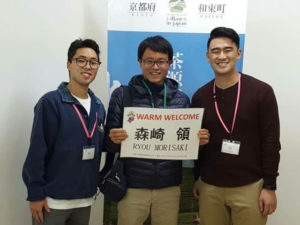December Great Story by Ryan Hirano, 2017-18 Greater Los Angeles Water Fellow
This past month I was fortunate enough to be selected to participate in a program called the Kakehashi Project. The Kakehashi Project is a fully funded trip to Japan, sponsored by the Japanese Ministry of Foreign Affairs, with the purpose to promote a strong relationship between Japan and the United States. All that was asked of participants was to share their experiences and findings from the experience. As a Japanese-American, this was an amazing opportunity to not only learn about my cultural heritage but do it at no cost to me.
Our itinerary for the trip was packed with activities and gave us a unique perspective on Japanese culture and lifestyle. The first stop of our trip was the Ministry of Foreign Affairs, where we received a lecture on the history and current state of foreign policy. We then visited Miraikan, a science museum. The word “miraikan” generally translates to “future museum” and showcased some of the scientific advancements taking place in Japan. Our next day focused on identity through the Japanese diaspora. As descendants of Japanese immigrants, we were all identified as nikkei-jin and connected through cultural characteristics with nikkei-jin in other countries, such as Brazil and Peru. Each group of Kakehashi Project participants split after touring the Japanese Overseas Migration Museum. My group headed to Kyoto area where we spent two days living in a traditional Japanese home in the town of Wazuka. Wazuka is a large producer of green tea and I spent part of the day working on a tea farm and enjoying some of the things that my host family spent their days doing and seeing. Our group participated cha-kabuki, a traditional tea tasting game that takes place annually throughout Japan. My homestay family informed us that the winner of the national cha-kabuki tournament would become nationally recognized and famous. After finishing cha-kabuki, we toured a soy sauce brewery where we learned about the complex process of making soy sauce. We then traveled to Nara and toured Todai-ji, home to the largest wooden building in the world as well as a 15m tall Buddha. Our group toured Osaka University with students the following day and learned about the history of the campus, the innovative research being conducted there, and the difference between American and Japanese universities. The last days of the trip were spent presenting what we learned and how we planned to utilize our learnings when sharing our experiences.
I left Japan feeling inspired through the Kakehashi Project events. One of my major takeaways, especially with relation to what we as Fellows do, was Japan’s relationship with nature. Japan grows upwards rather than outwards, meaning that despite the intensely packed urban centers, there is also plentiful natural spaces. In our visit to Todai-ji, in particular, the harmonious relationship with nature was evident as the famous deer of Nara park roamed the grounds of the temple. Another overarching theme of the trip was the ethos of hard work and discipline throughout all aspects of Japanese life. To the Japanese people, this attitude was not something to be praised or glorified as in American culture, but simply part of being a good, functioning member of society. It is something that I want to incorporate into my own lifestyle, not seeking recognition for working hard but simply doing it without expectation. Through conversations with my homestay family and with Japanese government officials, I also was able to understand an outside perspective of the United States. I was heartened by the fact that other countries do not judge or view individual Americans differently based on the current administration. While they do not agree with some of the current trends in our political climate, Americans are not seen as part and parcel of these issues. I was also inspired by other young Japanese Americans doing exciting work in many different sectors. I got a chance to speak with someone collecting stories from people who lived in the internment camps, a person working to inspire Asian-American leaders, and Japanese-Americans living and working in Japan. This experience felt especially timely as I have started to reflect on the next steps after our fellowship ends.
In Japanese, the word “kakehashi’ means “bridge.” The Kakehashi Project not only built a “bridge” between the United States and Japan but also serves as a “bridge” between all the young Japanese-Americans throughout the country fighting the good fight for a better tomorrow. The trip has helped me better connect with my cultural heritage and has given me better resolve and purpose to tackle the challenges of the new year. I will forever be indebted to the kindness of all those involved.

